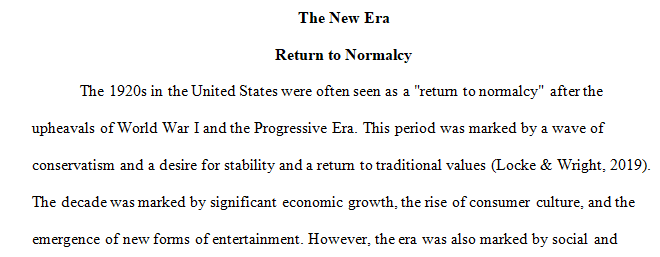Were the 1920s a “return to normalcy”? How did the 1920s reshape American way of life? How does Warren G. Harding make a case
Were the 1920s a “return to normalcy”? How did the 1920s reshape American way of life? How does Warren G. Harding make a case
- Chapter 22: The New Era
On a sunny day in early March 1921, Warren G. Harding took the oath to become the twenty-ninth president of the United States. He had won a landslide election by promising a “return to normalcy.” “Our supreme task is the resumption of our onward, normal way,” he declared in his inaugural address. Two months later, he said, “America’s present need is not heroics, but healing; not nostrums, but normalcy; not revolution, but restoration.” The nation still reeled from the shock of World War I, the explosion of racial violence and political repression in 1919, and, a lingering “Red Scare” sparked by the Bolshevik Revolution in Russia.”More than 115,000 American soldiers had lost their lives in barely a year of fighting in Europe. Then, between 1918 and 1920, nearly seven hundred thousand Americans died in a flu epidemic that hit nearly 20 percent of the American population. Waves of labor strikes, meanwhile, hit soon after the war. Radicals bellowed. Anarchists and others sent more than thirty bombs through the mail on May 1, 1919. After wartime controls fell, the economy tanked and national unemployment hit 20 percent. Farmers’ bankruptcy rates, already egregious, now skyrocketed. Harding could hardly deliver the peace that he promised, but his message nevertheless resonated among a populace wracked by instability.The 1920s, of course, would be anything but “normal.” The decade so reshaped American life that it came to be called by many names: the New Era, the Jazz Age, the Age of the Flapper, the Prosperity Decade, and, most commonly, the Roaring Twenties. The mass production and consumption of automobiles, household appliances, film, and radio fueled a new economy and new standards of living. New mass entertainment introduced talking films and jazz while sexual and social restraints loosened. But at the same time, many Americans turned their back on political and economic reform, denounced America’s shifting demographics, stifled immigration, retreated toward “old-time religion,” and revived the Ku Klux Klan with millions of new members. On the other hand, many Americans fought harder than ever for equal rights and cultural observers noted the appearance of “the New Woman” and “the New Negro.” Old immigrant communities that had predated new immigration quotas, meanwhile, clung to their cultures and their native faiths. The 1920s were a decade of conflict and tension. But whatever it was, it was not “normalcy.” Read more of Chapter 22 of The American Yawp http://www.americanyawp.com/text/22-the-twenties/
1) Were the 1920s a “return to normalcy“? How did the 1920s reshape American way of life? How does Warren G. Harding make a case for America’s “return to normalcy” in the primary source document,Warren G. Harding and the “Return to Normalcy” (1920))? http://www.americanyawp.com/reader/22-the-new-era/warren-g-harding-and-the-return-to-normalcy-1920/
2) What were the experiences of women and African Americans during the 1920s? What were the major issues or concerns facing both groups? How does Crystal Eastman explain her views on feminism and women’s right to vote in Crystal Eastman, “Now We Can Begin” (1920) http://www.americanyawp.com/reader/22-the-new-era/crystal-eastman-now-we-can-begin-1920/ , and Alain Locke promote his vision of the New Negro in his writing, Alain Locke on the “New Negro” (1925)? http://www.americanyawp.com/reader/22-the-new-era/alain-locke-on-the-new-negro-1925/
3)How did changes in consumption shape American society? How were the 1920s a time of “culture war” or clash between old and new cultural values? What does Ellen Welles Page’s writing reveal about phenomenon of “the Flapper” of the younger generation in the primary source document, Ellen Welles Page, “A Flapper’s Appeal to Parents” (1922)? http://www.americanyawp.com/reader/22-the-new-era/ellen-welles-page-a-flappers-appeal-to-parents-1922/
Requirements: 2 1/2 paragraphs
Answer preview for the paper on ‘Were the 1920s a “return to normalcy”? How did the 1920s reshape American way of life? How does Warren G. Harding make a case’

APA 965 words
Click the purchase button below to download full answer…….
